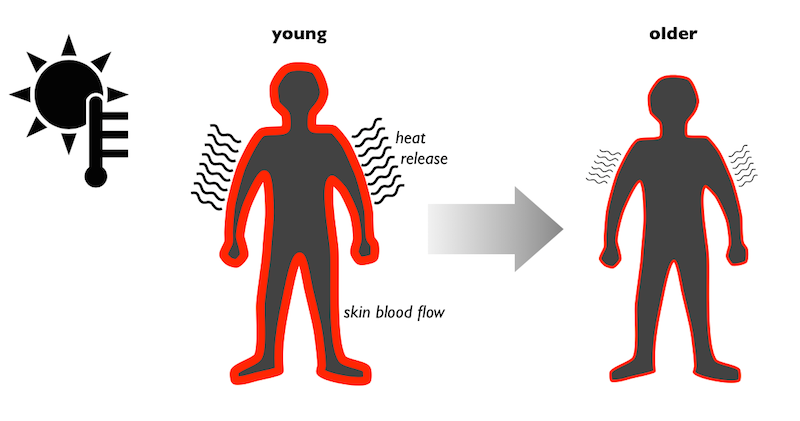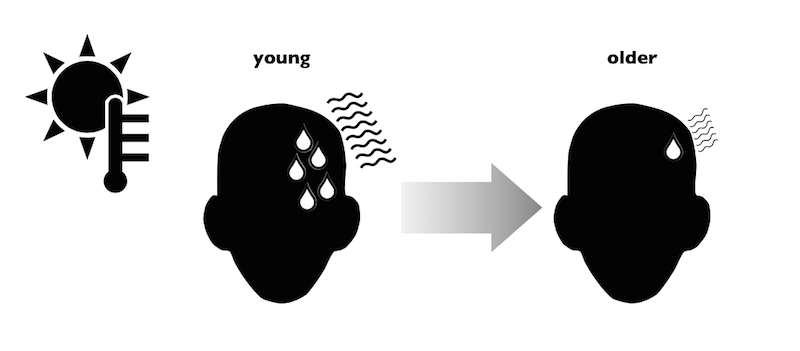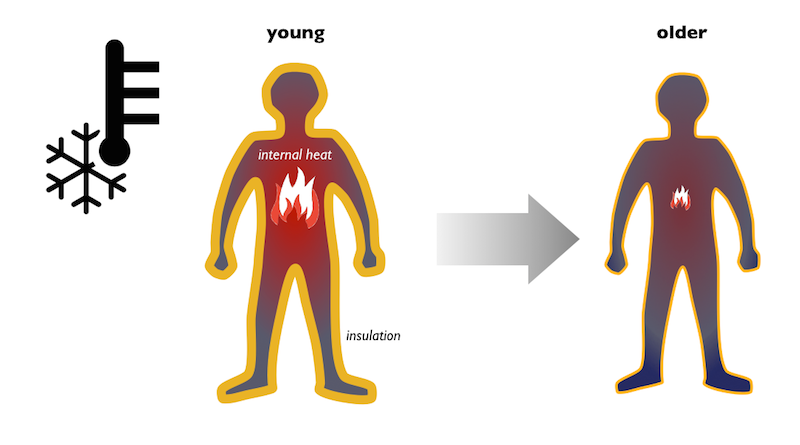Body Temperature
One central challenge we face equally humans is to maintain our internal trunk temperature in the range of 98.six°F (give or accept a few degrees). Our bodies function best inside a pretty narrow temperature span, and deviations in internal temperature—whether they are caused past stresses like do or exposure to hot or cold ambient conditions—can have serious consequences. We cope with these challenges by stimulating a coordinated set of responses aimed at maintaining body temperature inside its optimal range. Unfortunately, some of the mechanisms we rely on to regulate internal temperature get less effective as we historic period. Read on to learn about best practices for managing these seasonal ambient temperature challenges.
ane | Hot Weather condition
When exposed to hot conditions, sweating is one of the chief methods your body uses to control its temperature. Sweat, every bit it evaporates, helps cool the skin. Blood vessels feeding the peel besides dilate, which allows warm blood to flow to the pare surface. This helps remove estrus from the body core. However, these responses are less effective as we age. Our sweat glands produce less sweat and blood period to the skin is reduced. As a result, our ability to dissipate heat is compromised.
ii | Cold Weather condition
Exposure to common cold has its own unique challenges. In an effort to defend body temperature, our bodies subtract blood flow to the skin to reduce oestrus loss. We besides increase internal heat production through several mechanisms. 1 example is shivering—or the rapid wrinkle of muscles—which can quickly produce large quantities of rut within the torso. Only as we grow older, our bodies become less effective at controlling skin blood flow and generating internal heat. In add-on, the layer of fat nether our peel that acts equally an isolator and helps to conserve trunk heat thins with age. Because of these changes, it is harder for older adults to maintain internal trunk temperature in the "normal" range in common cold atmospheric condition.
Why does this matter? A reduced ability to maintain internal trunk temperature during heat or common cold stress can increase the risk for hyperthermia or hypothermia. In addition, coping with these conditions tin stress the cardiovascular system, which is too compromised with aging. Thus, when older adults are faced with the combined challenges of temperature and cardiovascular regulation, caution should be observed.
TIPS:
How can you bargain with hot or cold conditions as you lot age? Whether it is exposure to exterior temperatures or changes within your living space, here are some strategies to follow that can benefit your overall health and well-existence:
1 | What to Practice When It'southward Cold
Living in a common cold space for even a short flow of time can cause your torso temperature to reject and potentially cause hypothermia. In that location are several elementary steps that can be taken:
- Set your thermostat to at least 68°F to 70°F.
- Article of clothing layers of loose-fitting clothes around the firm, and warm clothes when you are sleeping.
- Drinkable warm beverages, simply avoid alcohol, which tin can increase oestrus loss from your body.
- Avoid going outside when temperatures are very common cold, but if yous do venture out, wear appropriate clothing (including a hat, gloves and scarf).
- Recall that people with some underlying chronic health conditions (like diabetes, hypothyroidism and cardiovascular diseases) are more susceptible to hypothermia and should be particularly cautious in cold conditions.
two | What to Do When It's Hot
Several lifestyle and health factors tin can increase your risk for hyperthermia. Here are some helpful recommendations:
- Living in a infinite with air conditioning (in hot weather condition) is important.
- On very hot days, stay indoors, and if you don't have air conditioning, find a space that does (mall, senior heart, library).
- If it is necessary to venture outdoors, pick a cooler time of the mean solar day (early on morning or evening are the all-time options).
- Potable enough of fluids throughout the day, as dehydration can have serious consequences.
- If you have existing medical weather similar hypertension, diabetes or Parkinson'due south disease, yous are particularly susceptible to rut-related injuries and should be extra cautious.
Columbine Health Systems Eye for Good for you Aging newsletter
Healthy Aging news delivered to your inbox monthly.
Kevin Kregel is a professor and the acquaintance provost for faculty at the Academy of Iowa. He earned a bachelor's degree and doctorate in physiology and biophysics from the University of Iowa, and afterward performed an NIH postdoctoral fellowship at the University of Arizona. Dr. Kregel has been at the University of Iowa since 1993, and he was department executive officeholder in the Department of Health & Homo Physiology prior to his date as associate provost. His extramurally funded research has focused on physiological adjustments to exercise, aging and ecology challenges. He has also been very agile at the national level, serving as the chair of committees addressing scientific discipline policy issues for the Federation of American Societies of Experimental Biology and the American Physiological Lodge.
georgrith2001.blogspot.com
Source: https://www.research.colostate.edu/healthyagingcenter/aging-basics/body-temperature/





0 Response to "what causes body temperature to rise at difficulty regulating"
Post a Comment